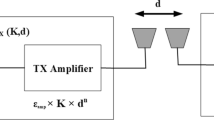Abstract
Power consumption is a fundamental concern in wireless multimedia sensor networks (WMSNs). Node placement scheme in WMSNs has considerable impact on network lifetime. In this paper, we investigate and develop an power-efficient node placement scheme (PENPS) in linear wireless multimedia sensor networks, which can minimize the average energy consumption per node and maximize the network lifetime. The analysis of PENPS and the comparison of performance with the equal-spaced placement scheme (EPS) show that PENPS scheme can significantly decrease the average energy consumption per node, which can prolong the lifetime of sensor nodes and sensor networks effectively.
Preview
Unable to display preview. Download preview PDF.
Similar content being viewed by others
References
Akyildiz, I.F., Weilian, S., Sankarasubramaniam, Y.: A survey on sensor networks. IEEE Communications 40, 102–114 (2002)
Akyildiz, T.M.I.F., Chowdhury, K.R.: A survey on wireless multimedia sensor networks. Computer Networks 4, 921–960 (2007)
Hsieh, T.T.: Using sensor networks for highway and traffic applications. IEEE Potentials 23, 102–114 (2004)
Nekovee, M.: Sensor networks on the road: the promises and challenges of vehicular adhoc networks and vehicular grids. In: Proceedings of the Workshop on Ubiquitous Computing and e-Research, Edinburgh, UK (2005)
Ye, W., Heidemann, J., Estrin, D.: Medium access control with coordinated adaptive sleeping for wireless sensor networks. IEEE/ACM Transaction on Networking 12, 493–506 (2004)
Zheng, T., Radhakrishnan, S., Sarangan, V.: Pmac: An adaptive energy-efficient mac protocol for wireless sensor networks. In: Proceedings of IEEE WMAN 2005, Denver, Colorado, USA, pp. 65–72 (2005)
Singh, S., Raghavendra, C.S.: Pamas: power aware multi-access protocol with signaling for ad hoc networks. ACM SIGCOM Computer Communication, 5–26 (1998)
Rabaey, J., et al.: Pico radios for wireless sensor sensor networks: The next challenge in ultra low power design. In: Proceedings of the ISSCC (2002)
Chen, B., Jamieson, K., Balakrishnan, H., Morris, R.: Span:an energy efficient coordination algorithm for topology manitenance in ad hoc wireless. In: Proceedings of mobicom (2001)
Cerpa, A., Estrin, D.: Ascent: Adaptive self-configuring sensor networks topologyies. In: Proceedings of infocom (2002)
Liu, Y., Liu, X., Xiao, L.: Location-aware topology matching in p2p systems. In: Proceedings of infocom (2004)
Ganesan, D., Cristescu, R., Beferull-Lozano, B.: Power efficient sensor placement and transmission structure for data gathering under distortion constraints. In: Proceedings of the third international symposium on Information processing in sensor networks, pp. 26–27 (2004)
Gupta, H., Navda, V., Das, S.R., Chowdhary, V.: Efficient gathering of correlated data in sensor networks. In: Proceedings of the 6th ACM internationalsymposium on Mobile ad hoc networking and computing, Urbana-Champaign, IL, USA, pp. 402–413 (2005)
Maneva, E., Bogdanov, A., Riesenfeld, S.: Power-aware base station positioning. In: Proceedings of Infocom (2004)
Wu, J., Yang, S.: Smart: a scan-based movement-assisted sensor deployment mehtod in wireless sensor networks. In: Proceedings of infocom (2005)
Porta, T.L., Wang, G., Cao, G., Zhang, W.: Sensor relocation in mobile sensor networks. In: Proceedings of infocom (2005)
Liu, Y., Ngan, H., Ni, L.M.: Power-aware node deployment in wireless sensor networks. In: Proceedings of IEEE SUTC 2006 (2006)
Maleki, M., Pedram, M.: Qom and lifetime-constrained random deployment of sensor networks for minimum energy consumption. In: Information Processing in Sensor Networks, pp. 293–300 (2005)
Chang, H., TAssiulas, L.: Energy conserving routing in wireless ad hoc networks. In: Proceedings of infocom, pp. 22–31 (2001)
Bhardwaj, M., Chandrakasan, A.P.: Bounding the lifetime of sensor networks via optimal role assignments. In: Proceedings of infocom, New York, pp. 1587–1596 (2002)
Srikant, R., Shakkottai, S., Shroff, N.: Unreliable sensor grids: Coverage, connectivity and diameter. In: Proceedings of infocom (2003)
Franceschetti, M., Booth, L., Bruck, J., Meester, R.: Covering algorithms, continuum percolation, and the geometry of wireless networks. Annals of Applied Probability 13 (2003)
Pottie, G.J.: Wireless sensor networks. In: Information theory workshop
Min, R., Chandrakasan, A.: Energy-efficient communication for ad-hoc wireless sensor networks. In: Conference Record of the Thirty-Fifith Asilomar Conference on Signals, Systems and Computers, vol. 1, pp. 139–143 (2001)
Xiong, N., Yang, L.T., Cao, J., Yang, Y., He, Y.: PIDNN: An Adaptive and Predictive Approach for Autonomic Multicast Networks. ACM Transactions on Autonomous and Adaptive Systems: Special Issue on Adaptive Learning in Autonomic Communication (2008)
Xiong, N., Defago, X., Jia, X., Yang, Y., He, Y.: Design and Analysis of a Self-tuning Proportional and Integral Controller for AQM Routers to Support TCP Flows. In: IEEE INFOCOM 2006, Barcelona, Spain (2006)
Author information
Authors and Affiliations
Editor information
Rights and permissions
Copyright information
© 2008 Springer-Verlag Berlin Heidelberg
About this paper
Cite this paper
Cao, M., Yang, L.T., Chen, X., Xiong, N. (2008). Node Placement of Linear Wireless Multimedia Sensor Networks for Maximum Network Lifetime. In: Wu, S., Yang, L.T., Xu, T.L. (eds) Advances in Grid and Pervasive Computing. GPC 2008. Lecture Notes in Computer Science, vol 5036. Springer, Berlin, Heidelberg. https://doi.org/10.1007/978-3-540-68083-3_37
Download citation
DOI: https://doi.org/10.1007/978-3-540-68083-3_37
Publisher Name: Springer, Berlin, Heidelberg
Print ISBN: 978-3-540-68081-9
Online ISBN: 978-3-540-68083-3
eBook Packages: Computer ScienceComputer Science (R0)




